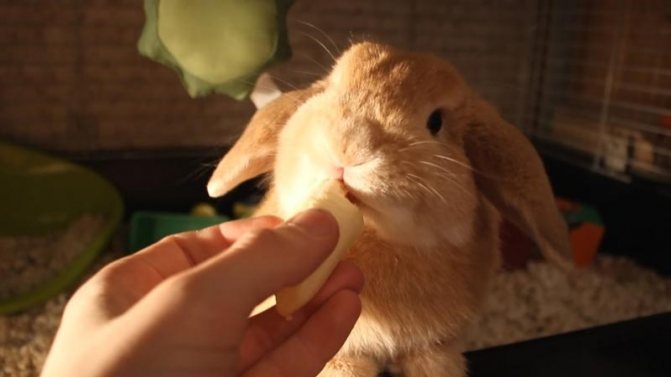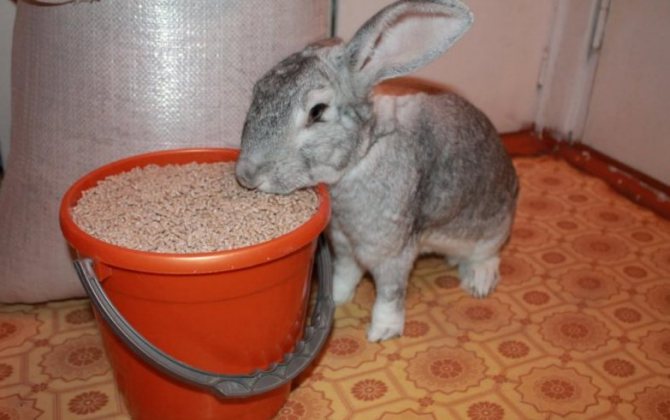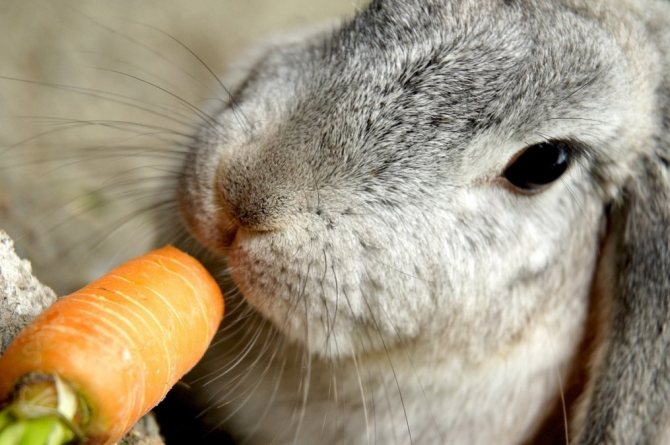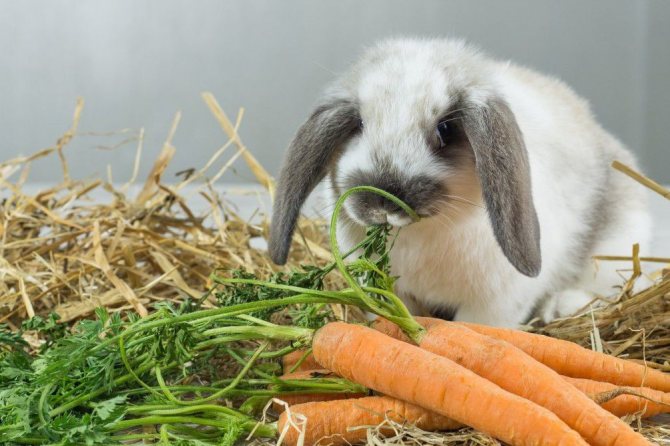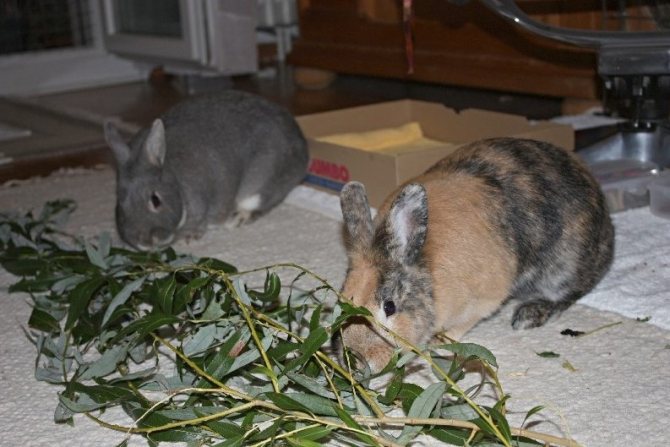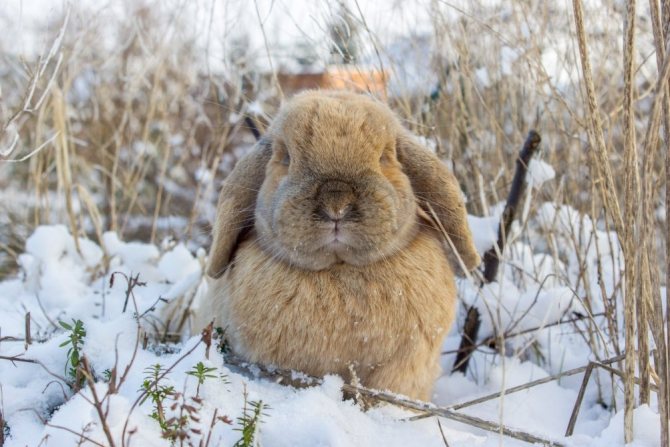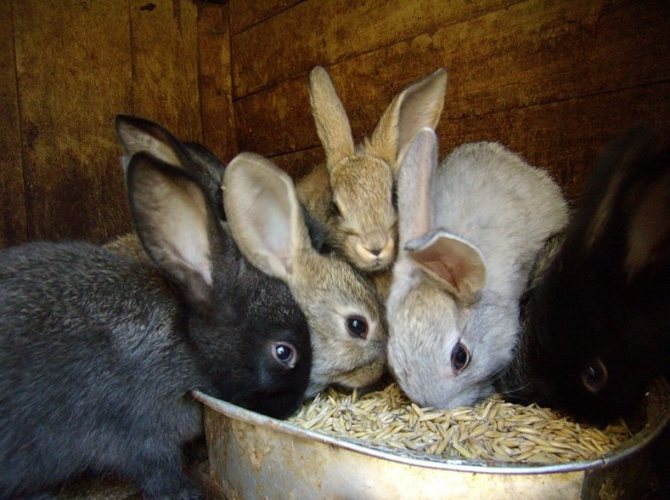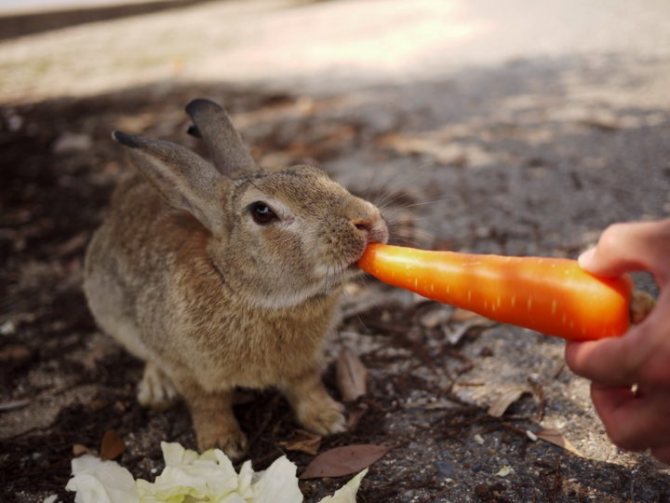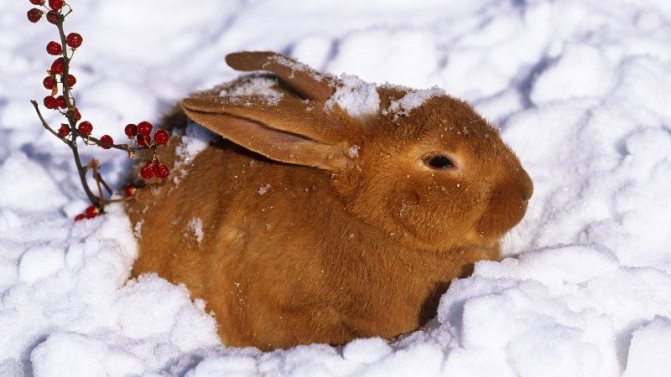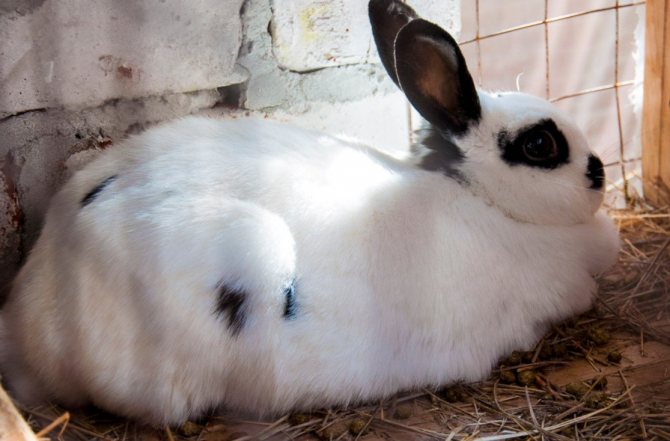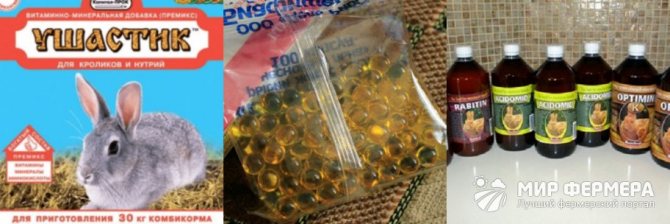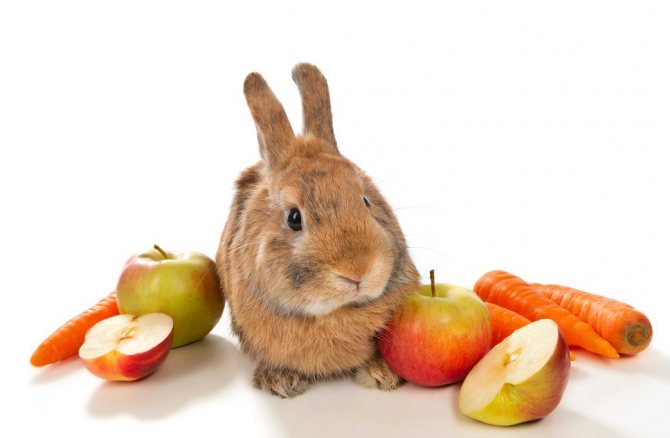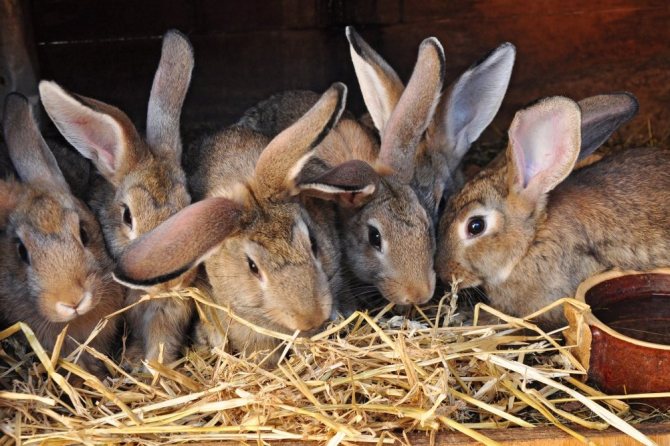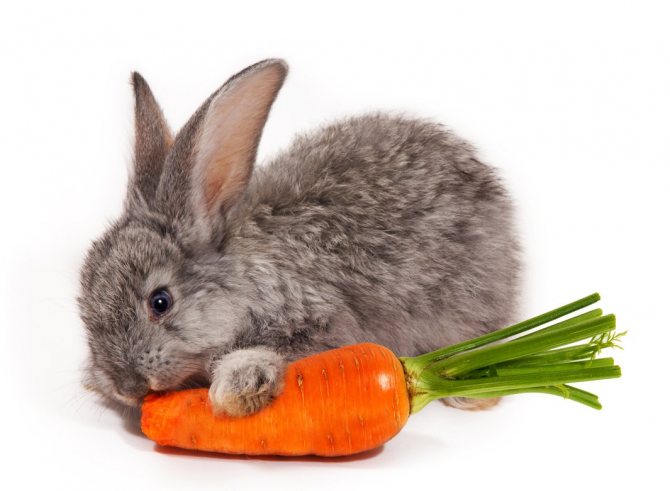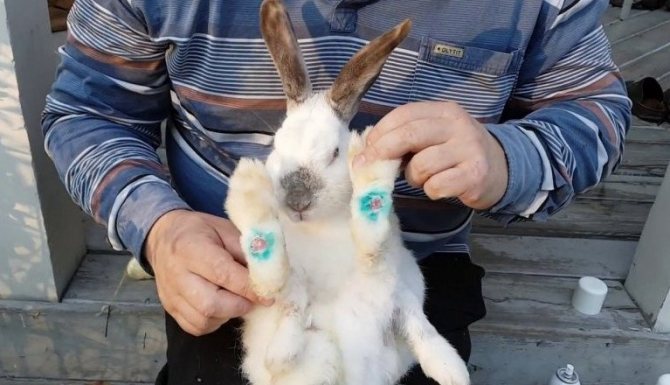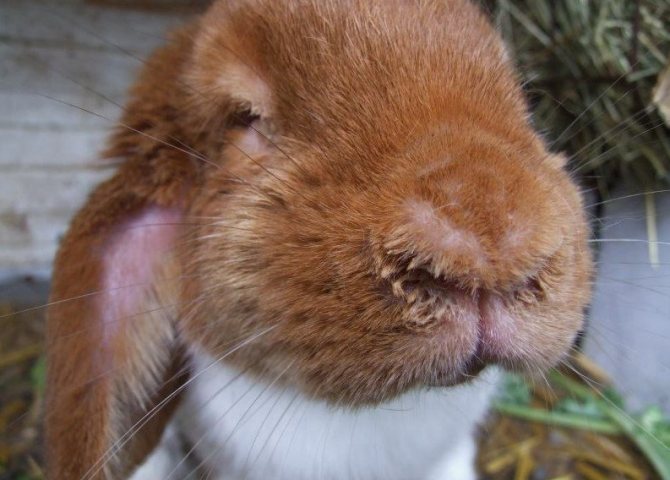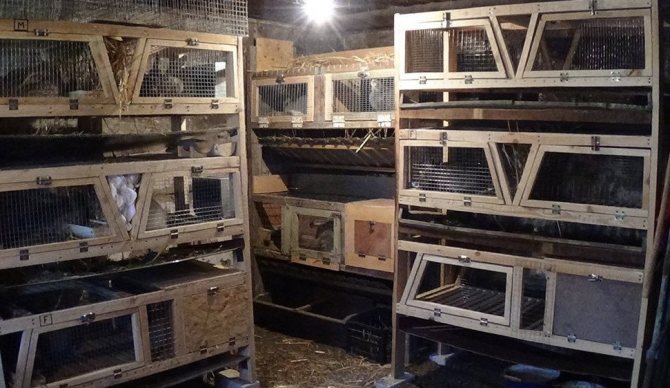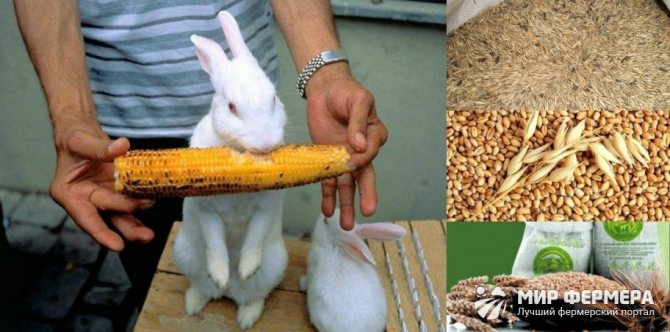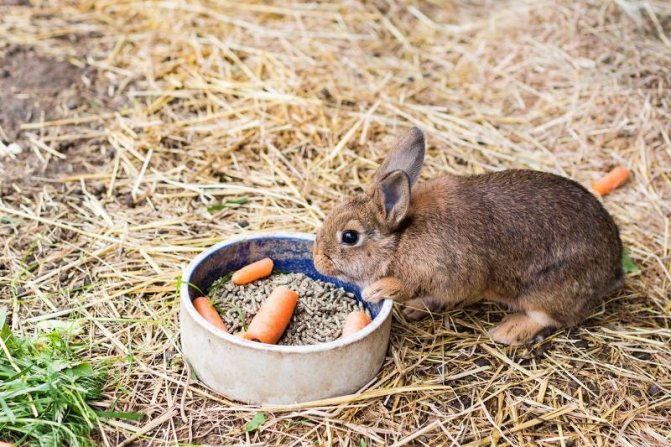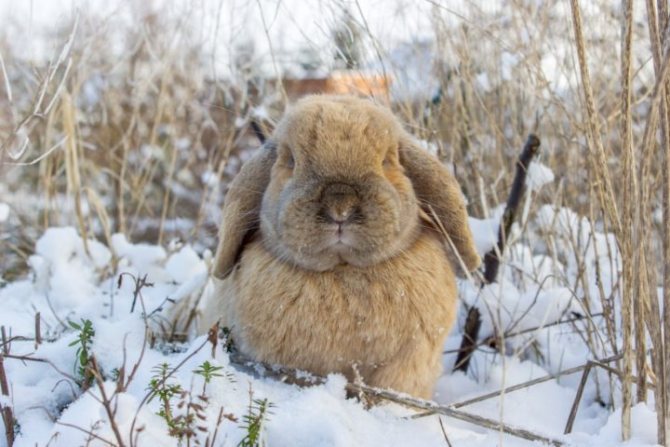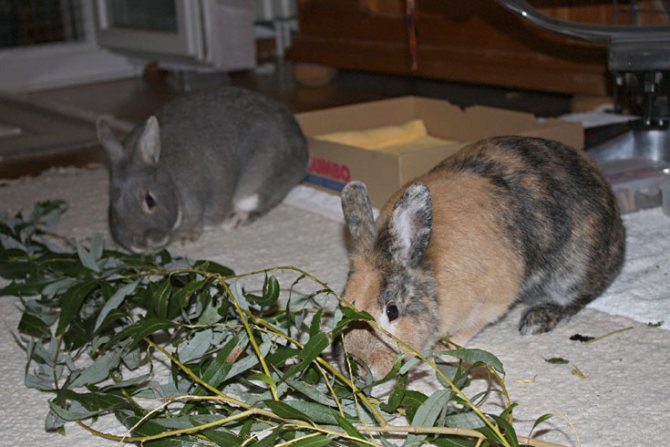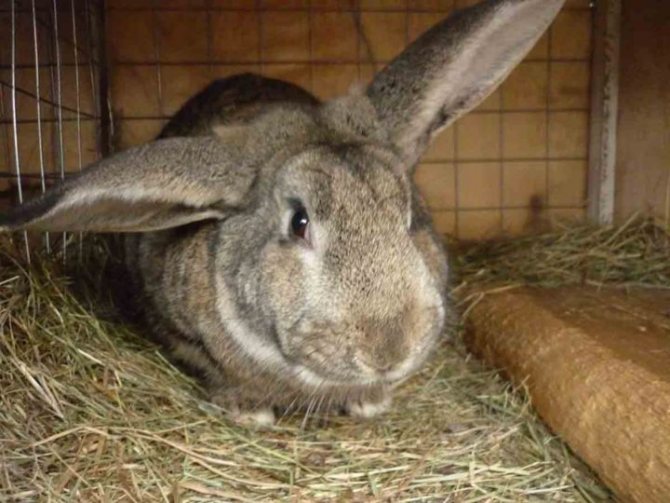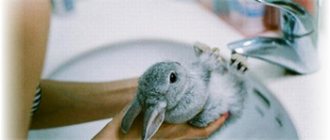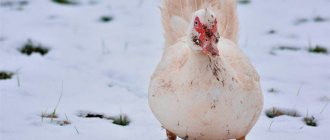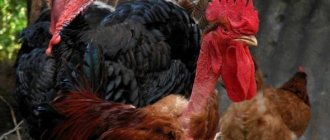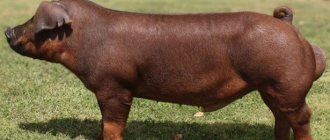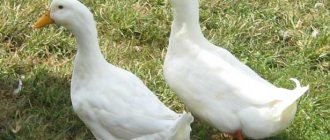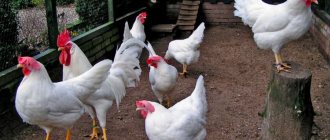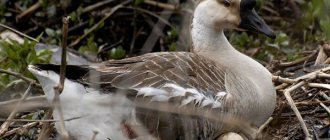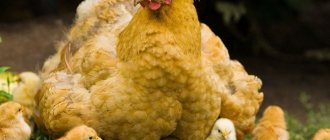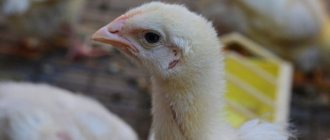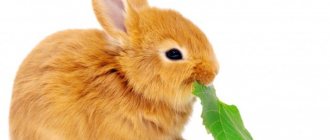11 minutes to read the article
PhotoVideoComments
Feeding rabbits in the cold season is significantly different from feeding in summer. The lack of green grass, which was the basis of the diet, creates certain difficulties in the selection of food. How to feed rabbits in winter so that the animals do not lack nutrients, do not lose weight and can fully reproduce?
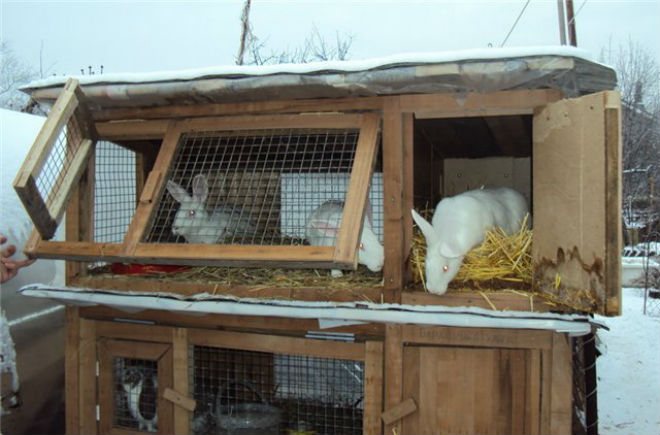
In the cold season, good nutrition will help preserve the livestock population.
Types of feed
In winter, rabbits have a good appetite. For high-quality growth, these animals require a balanced diet throughout the year. In summer, they feed on green grass, carrots, vegetable tops. Eating a pet decorative pet in winter has its own characteristics.
It is required to feed rabbits at home in winter with dry food with the addition of root crops. Dry feed mixtures in an open-air cage are made in advance, they must contain the following:
Winter feeding for rabbits should include the following foods:
- juniper, spruce, wasp branches;
- hay - 61% of the daily amount of food;
- root crops - carrots, potatoes;
- cereals - wheat, barley, corn, millet;
- beans - beans, lentils, peas.
Correct and full-fledged winter feeding provides for the presence in the diet of mixtures from pet stores, salt stone to replenish the needs for silicon and magnesium. It is important not only to provide a high-quality diet, but also to drink enough. The water is changed every day and its purity is monitored throughout the day. Rabbits are clean animals, constant cleaning of the feeders is required.
Features of the diet of pregnant females
It is necessary to select potential winter “mothers” well in advance. They are placed in special insulated queen cells. Breeding rabbits outdoors in winter requires constant cleanliness in the cages, proper and nutritious nutrition. In specialized stores, to help rabbit breeders, they also sell compound feed, granulated food, all the necessary additives and complex elements. This makes it easier for the owner, since the composition is completely balanced in terms of essential nutrients.
Experienced rabbit owners say that in winter, expectant mothers are given sprouted oats, fresh carrots at least once a week, and periodically they can be fed with boiled potatoes. Only the full provision of the female with all the necessary substances and elements will allow her to get a good and healthy birth. Few people know, but special food is given to all pregnant females and it continues for at least 2 weeks after the birth of babies.
A rabbit that has given birth requires careful, special care. Correctly organized feeding of females will provide a favorable breeding, since only healthy and well-fed animals can mate well and give tenacious breeding with a normal number of babies. If everything is done correctly, the female will give birth to healthy babies in time. If you keep rabbits in the winter, you can get more offspring. Often, the number of winter okrol exceeds the summer one.
Features of feeding in the winter
They feed rabbits at home in winter with fresh hay, less often straw.It does not contain useful elements in the required amount, but it is suitable for bedding.
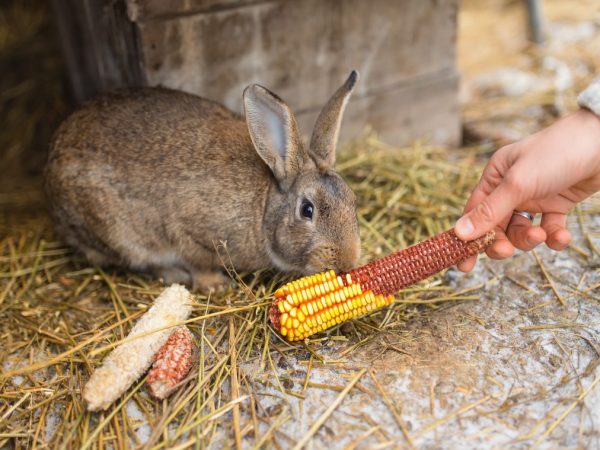

The winter diet should be varied and balanced, include the necessary trace elements, vitamins, fiber, carbohydrates
With a lack of fortified food, animals are able to consume their morning droppings. This will not harm the pussies, it will strengthen the immune system. Fresh rabbit droppings contain useful elements when fed with coarse food. Such products are not assimilated the first time, because animals consume their feces, following the needs of the body.
With repeated digestion, the food is absorbed better.
Feeding rabbits in winter is required as many times as certain breeds require. The food of such animals at home depends on the age and condition of adults and rabbits. The number of feedings and the time must be the same. The regimen has a beneficial effect on their body.
- minimum - twice a day, in the morning and evening;
- optimal - 5-6 times (every 3-4 hours).
In winter, it is worth monitoring the state of the water, especially if yard, aviary or outdoor maintenance is practiced. When it gets cold outside, the liquid in the drinkers freezes, the rabbits begin to gnaw on the ice, which is quite dangerous for their health.
During the period of illness, fluffies have poor appetite, they lose weight, and their immunity weakens.
Warm food and water in winter improves the digestion of animals. Winter feeding in rabbits before slaughter involves the elimination of beans, which lead to flatulence, beets, which have a laxative effect. Potatoes digest well, but they need to be mixed with enough hay and dry mixes.
The transition to winter food is carried out in stages. Portions with herbs are reduced every day, and then excluded altogether.
Olga Nevolina (Veterinarian):
Such a smooth transition is carried out within 5-7 days. In the process of changing the diet, the enzymatic composition of the digestive juices changes slightly, the gastrointestinal tract is gradually rebuilt to a different composition of feed.
Methods for breeding rabbits for meat
Females give birth to babies all year round. They reproduce mainly every 4-5 months. Young individuals over 4 months old are suitable for reproduction. In the winter cold, rabbits can withstand low temperatures. Thanks to this, such individuals are stronger and more resilient, grow quickly, in comparison with babies born at a different time. It is for hardened rabbits that the future is: they make excellent producers and productive females. Animals born in winter are valued more.
Animals reproduce excellently: up to 14 babies can be born per okrol. They are proud of the born winter rabbits - they are sure to be left "for divorce". They are born naked and blind, so only the careful care of the female will allow the rabbits to come out. But not always the quantity that is born is nursed.
You need to mate animals according to the scheme. An older female who has already participated in successful round-ups is more suitable for coverage. So each rabbit will be born alive and healthy, and the risk that the mother will not take care of them will be minimal. Mating is best planned on frost-free days. After all, roundabouts in severe cold are usually not productive.
Rabbit farming is not an easy branch of agriculture. Only high-quality care, proper feeding can ensure the effectiveness of the activity.
Chalk and salt should always be in the feeder, sprouted wheat grains give to provide fortified food. The food must include zucchini, carrots, a small amount of boiled potatoes. The dosage of roughage before rounding is reduced by increasing the volume of concentrates.
Lactating females are not restricted in drinking, they continue to be given mineral and vitamin supplements.As part of the mash, kefir and whey are used to increase the volume of milk. Pumpkin and silage have a positive effect on lactation.
Meadow hay is required, high quality. It is recommended to increase the amount of concentrated feed to 60%. The dosage of meat and bone meal is gradually, starting from the first month, increased from 8 grams to 20-40.
The daily amount of dairy products at one month of age is reduced by up to 25%. At this time, the little ones begin to cut their teeth and gradually you can begin to feed them with bran and, in small quantities, with fresh hay, in which there should not be thick coarse stems.
Rough food should not be allowed to enter the stomachs of rabbits. It is recommended to add juicy feed to the diet only from 3 months of age. Rabbits should always have clean water. If they themselves do not drink it, you need to water the kids from a syringe.
In winter, the frequency of feeding rabbits should be 5-6 times. It is especially important to observe this regimen after weaning about the mother, so that the rabbits, even at low temperatures, do not starve and gain weight.
Animal nutrition is the backbone of rabbit farming.
In large and medium-sized farms with 200 heads and more, both technologies are being introduced simultaneously. In households, the usual method of feeding is used.
The peculiarity of the method lies in the short feeding times of young animals and saving on cages. One feeding cycle takes 90 days.
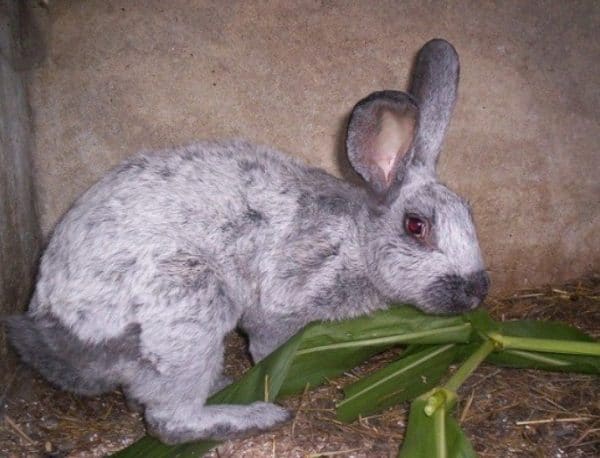

Feeding rabbits at home is not complete without hay and branches of various trees.
During feeding, the rabbits remain with their mother. After finishing feeding, the female is transferred to the male for mating. The rabbit brings up to 24 cubs per year.
Rabbit breeders with extensive experience use auxiliary methods to activate pet weight gain.
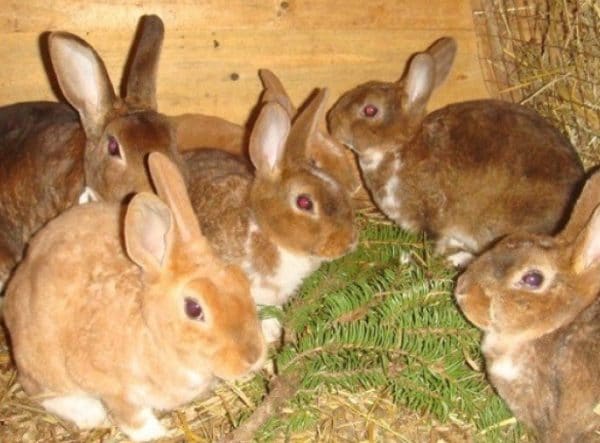

The basis of the winter diet of rabbits is roughage and concentrated feed.
Additional productive methods that provide weight gain in animals include:
- Rational seating of rabbits. In a herd, animals are divided into stronger and weaker ones. All pets are required to receive food in equal portions. To do this, you need to group rabbits according to their temperament.
- Limited space. The mobility of the rabbits is limited by the small area. With minimal movement, rabbits can gain weight quickly.
- Control over the filling of the feeder. After each feeding (4-5 times a day), the food container is cleaned out. Empty food boxes are refilled.
Breeders successfully use another feature of rodents - activity at night. Shielding the cage from daylight increases the rabbits' need for food. But regular overexposure of animals in semi-darkness is contraindicated.
Breeders add vitamins to pet food to improve appetite. Useful substances of groups A and E are used together with fats, vitamin D is added to thick and mushy feed. The drink is diluted with vitamin C.
After consulting a veterinarian, the animals are prescribed vitamin-mineral supplements, as well as protein-vitamin-mineral supplements (BVMD).
They strengthen the body of animals with useful microelements: manganese, calcium, phosphorus. Protein-rich options provide animal muscle with protein.
Vitamin and protein supplements have no contraindications. The correct dosage is calculated taking into account the body weight and age of the pet. The use of additives above the norm impairs the taste characteristics of rabbit meat.
Winter diet
In winter, the rabbits are given quality hay. Its preparation is carried out according to certain rules: the grass is mowed before flowering in early summer, it is dried and left for the winter. If the hay is too dry, grass flour is prepared from it. The diet of decorative and ordinary rabbits, rabbits contains carrots, cabbage.
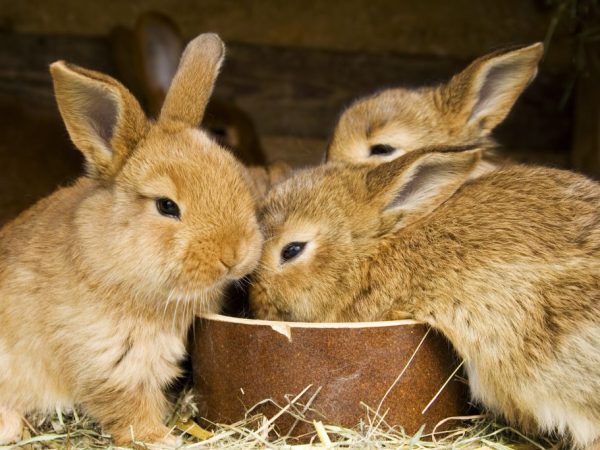

Rabbits are happy to eat twig food - this is an integral part of the winter diet.
Vegetables are finely chopped, mixed with grass flour.
Useful preparations for the winter include nettle shoots, which should be collected in the summer and dried in the form of brooms. Twigs of trees containing trace elements are suitable for animals.
It is important to observe a variety and balanced diet. Rabbits eat cereals and low-fat soups, other bait is also offered, while the food should not be saturated with fats and hot spices. Otherwise, digestion is disturbed in rabbits.
Possible problems
If rabbits are improperly kept on the street in winter, rabbit breeders are faced with acquired diseases.
If symptoms of colds have been identified, animals are transferred to a room: home, in a warm barn or greenhouse.
Rhinitis
A common illness that can occur in cold winters is rhinitis.
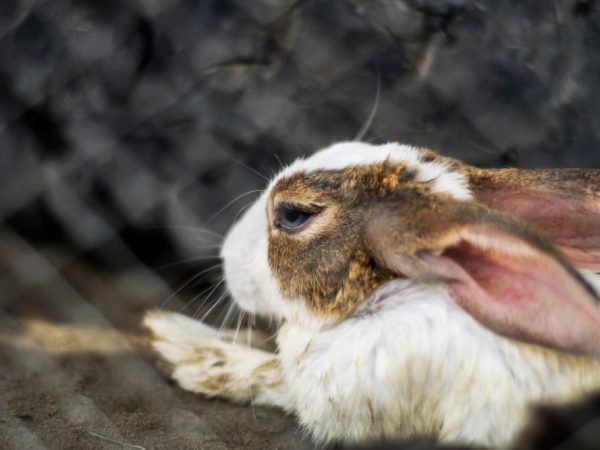

In case of rhinitis, the animal must be shown to the veterinarian and kept in a warm room until it recovers.
It is accompanied by frequent sneezing and sinus discharge. Rabbits begin to refuse food and become lethargic. Without moving the cold animals to a warm room until complete cure, simple rhinitis passes into the infectious stage and passes with complications, manifested initially in the form of purulent discharge from the nasal cavity. Can be fatal.
Dermatitis
Pododermatitis is an inflammatory process on the soles of the paws. It appears due to damp bedding accompanied by low temperatures.
In the cold and high humidity, the paws crack and, if an infection hits, the wounds quickly quickly become inflamed.
Frostbite
With sharp changes in temperature in winter, accompanied by a strong wind and high humidity, frostbite is possible, which is divided into degrees:
- the first is characterized by swelling and redness of the affected areas of the skin, the affected animal is transferred to heat, and the frostbitten areas are lubricated with fat;
- the second leads to the appearance of water blisters, the bubbles filled with liquid are opened and treated with camphor ointment;
- the third is associated with the drying out of the frostbite areas and the subsequent death of the skin, in such cases it is not worth treating rabbits with your own hands, the treatment is carried out only by a veterinarian in a clinical setting.
Meals during the mating season
When mating, feeding rabbits during the winter includes the following:
- corn, barley, bone meal;
- minerals;
- vitamins - hay, vegetables, fruits;
- fiber - cake, bran.
Such a diet for a pet in winter will help maintain the health of pets, but remember the correct proportions.
100 g of food should contain 30 g of cake and bran, 15 g of protein, 4 g of mineral supplements. Overfeeding can lead to health problems. Improper feeding in winter will negatively affect the performance of animals.
Olga Nevolina (Veterinarian):
In the diet of animals that are intended for breeding, vitamin E must be present - an important assistant to the reproductive system. It is found in cereals, vegetable oils, eggs, nuts. With poor feeding, it is possible to use vitamin E in a synthetic form, adding to the main diet.
In open-type conditions, newborn rabbits will have to be additionally warmed while their mother goes to feed. It is better to fence off the mother liquor and give the hare feed in a separate place, not far from the offspring.
21 days before mating, pets are fed with special foods. At the same time, they gain weight, which contributes to a good mating result.
Preparing for winter
If the owner plans to keep rabbits in cages outdoors in winter, it will be necessary to prepare for the cold in advance. This mainly concerns the correct placement and insulation of cells.
Rabbit dwellings are best placed against the wall of a shed or other building. They must be placed at least 80 cm above the ground. It is more convenient and warmest to make a stand from wooden pallets from thick boards, this will prevent the flow of cold from below from the frozen ground.
If the floor in the cages is mesh, it must also be insulated. For this, a thick layer of straw or hay is poured. In addition to protecting from the cold, the litter will perform another function - to absorb excess moisture.
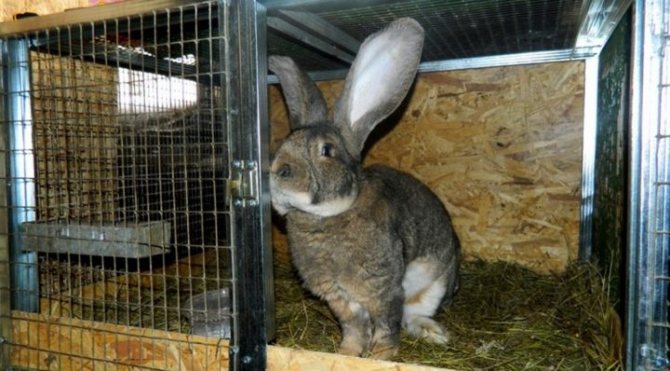

Straw Insulated Cage
The walls of the cage also need to be insulated for the winter. For this, special heat-insulating materials or improvised means are suitable: felt, polystyrene, old blankets, which are fixed from the outside.
The best option is double cell walls. Between them, for additional insulation, you can place straw, dry foliage, moss, foam rubber, felt. To enhance the thermal insulation properties, plywood sheets can be stuffed on top or stretch plastic wrap.
It is impossible to leave without additional insulation and the entrance to the cage. It is covered with cut-to-size plywood or durable glass. The second option is more preferable, as it provides access to light.
It is imperative to think over the ventilation system so that the animals do not suffer from a lack of fresh air. Leave openings for air inlet, but position them to avoid drafts. With the onset of spring, the insulation is removed in order to avoid the development of pathogenic fungi and to exclude overheating of animals.
In case of a significant drop in temperature, the cells are covered from above with bedspreads, blankets, and old outerwear. Many farmers fill their cage space with a lot of hay, which traps the heat from the animals' bodies and breath.
And yet, even having taken all measures for maximum insulation, it is advisable to transfer the cells to the room when severe cold weather sets in. In this case, it is necessary to exclude the simultaneous keeping of other animals in it. The noise from them can stress rabbits. And a large concentration of gases accumulating in a closed room with a large number of animals can negatively affect the condition of the animals, provoke diseases and even lead to death.
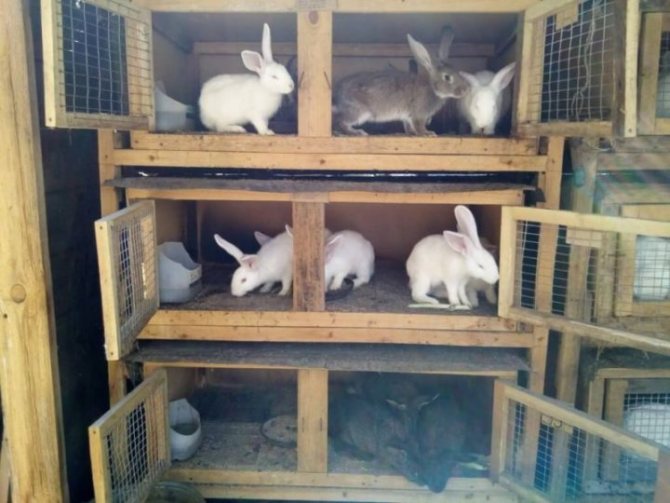

It will be warmer in the shed! ..
Another widely used option for keeping rabbits in the winter is to put them in a greenhouse. The main requirements for a greenhouse: it must be light, with good ventilation, without cracks and crevices (to avoid drafts).
There are two options for this placement:
- cells are transferred to the greenhouse;
- an open-air cage is being built in the greenhouse, into which rabbits are released.
In the first case, the greenhouse should be large enough so that after placing the cells, there is a passage for maintenance (to distribute food, remove waste).
If the farmer decided to arrange an open-air cage in the greenhouse in which the rabbits will live in winter, then it is better to prepare it in advance. After the harvest is harvested, an open-air cage is built inside the greenhouse. To avoid undermining, the fence must be buried in the ground for about half a meter.
Keeping rabbits in a greenhouse in winter has many advantages:
- thanks to the free space, animals feel at ease, dig holes, arrange nests, actively reproduce;
- such placement saves materials and time, because in addition to the construction of the aviary, no additional measures are needed (polycarbonate, from which greenhouses are made, has excellent insulating properties, and ventilation in greenhouses is usually provided);
- an undoubted plus is the natural fertilization of the soil. Plants planted in the spring where the rabbits hibernated will grow quickly and yield a good harvest.
What can you feed rabbits in winter
If you want to have a rabbit, you must take into account all the nutritional features of your pet.How to feed rabbits in winter is very important, since it is at this time of the year that animals need energy and warm food.
Rabbits are animals that constantly eat something, and therefore their feeder should always be filled with something tasty.
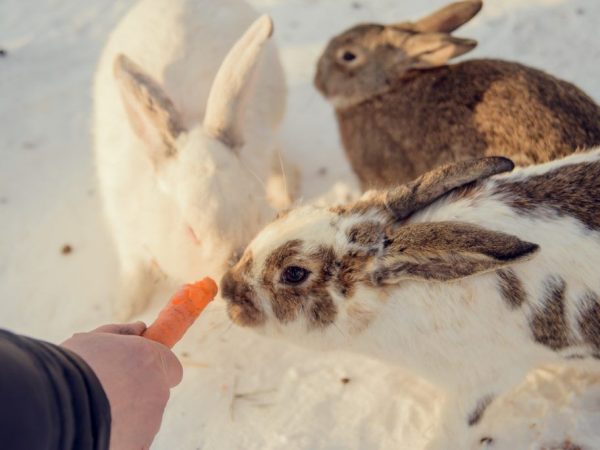

What to feed rabbits in winter
How to feed rabbits at home in winter? It is very important for a decorative rabbit to provide all the necessary vitamins, which can be obtained both in supplements and in fruits. It is imperative that hay should be given in the winter, as the animals are warmed by it.
Depending on the season, nutritional problems can be quickly resolved with the right diet. It is worth paying special attention to the winter season. You can feed pets in winter with food prepared from the summer period.
How to feed properly?
The peculiarity of all rodents is that they constantly eat something. Rabbits are no exception. Therefore, when kept at home, only fresh, healthy and favorite food should be in their feeders. In the summer, the power problem is solved quite simply. Fresh plant foods contain enough vitamins for their harmonious development. Fresh green grass, vegetable tops, twigs, carrots. All this helps to maintain a balance in the diet of these domestic animals.
In addition to fresh feed, they usually give additional compound feed, which is sold in specialized stores. Rabbits love to feast on oats, corn, and barley.
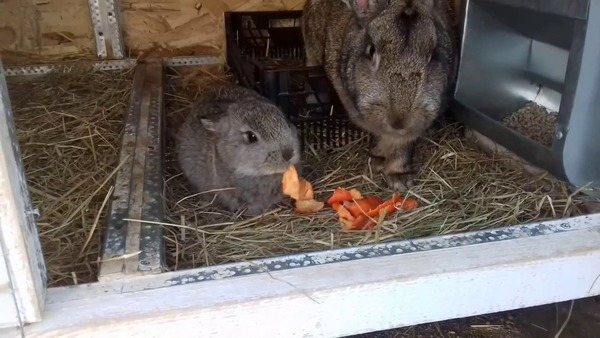

For these animals, the main groups of feed are distinguished:
- Juicy. Root vegetables, silage, pumpkin, zucchini, fruits and berries.
- Rough. Straw, hay, tree branches.
- Green. Forbs, plantain seed, rhubarb, nettle, freshly cut grass.
- Concentrated. Grains, any combined feed, except for those with which the birds are fed.
- Animals. Bone meal, milk.
- Food (from the table of breeders). The main thing is that the food is fresh and free of mold. Rusks, peelings of carrots and potatoes, leftover cereals.
- Supplements that contain minerals. Chalk and salt.
Rabbits can be fed either mixed or dry. Dry feeds include special combined feeds, they contain the entire range of essential nutrients. Mixed assumes feeding with different mixtures. Such food should be selected depending on the age of the rabbits.
Fresh water should be in the aviary in sufficient quantity and at any time of the year. The opinion that animals get the necessary moisture from feed is erroneous.
Necessary products
Rabbits are whimsical in terms of feeding. The main thing is that the feeding of rabbits in winter is balanced and complete. Even in winter, they need to get enough vitamins, just like in summer. Their diet should consist of proteins, fats and carbohydrates, and the amount of food should not decrease with the change of the season.
Foods consumed by rabbits in winter include:
- hay;
- various tree branches (spruce, juniper, aspen);
- Apple.
In no case should rabbits be given plums, cherries, peaches, because due to their high acidity, they are poisonous to animals. Everything else, namely potatoes, carrots, cabbage, peas, barley, millet and other cereals and legumes, should be stored not only for the whole family, but also for rabbits. Winter feeding for rabbits is not complete without specialized mixtures and feeds, which are sold in pet stores.
An important factor is that eared people often feel the need to consume salt. You can solve this problem by purchasing a salt stone from a pet store. Rabbits are clean animals, they observe cleanliness both in nutrition and in taking care of themselves, therefore, if it is decided what to feed the rabbit in winter, you also need to take care of the quality of the products.In winter, pussies drink especially a lot, so the water in the cages should always be clean and abundant.
Feeding pregnant and lactating rabbits
In the summer, there are no special problems with feeding rabbits, because they are equally willing to eat chopped vegetables, fresh herbs, and even some food waste. In winter, the diet should be more balanced, since energy and nutrients are spent not only on gaining weight, but also on maintaining an optimal body temperature.
That is why you should prepare for winter maintenance in advance. Preparation includes, first of all, the preparation of a sufficient amount of feed in accordance with generally accepted recommendations for feeding rabbits in the cold season.
Rates and types of feed
In order to correctly formulate a diet for animals, you need to familiarize yourself in advance with the preferred types of feed and their consumption rates per animal per day (Figure 2).
In general, all suitable food for rabbits can be roughly divided into several groups:
- Juicy: This includes any vegetables and melons, but most of all rabbits love fresh chopped carrots, beets, turnips or turnips. Silage is also a valuable source of vitamins in winter.
- Rough: These foods play an important role in the physiology of rabbits, as they are able to normalize the digestive process. This group includes straw, high-quality legume or cereal hay, as well as branches of coniferous and deciduous trees.
- Green: This food group forms the basis of the diet in summer, when animals can be fed ad libitum with rhubarb, alfalfa, dandelions, nettles or other meadow grasses. Naturally, with the arrival of cold weather, it is very problematic to provide the livestock with a sufficient amount of greenery.
- Concentrated: Provides a valuable source of nutrients and energy. Rabbits can be given crushed corn soaked in water, oilcakes, oats (whole and crushed), bran and any industrial feed, except for those intended for feeding poultry.
- Animal feed, such as bone meal, whey, skim milk, buttermilk or fish oil, can help feed your animals with valuable nutrients and protein.
- Food Waste: This feed group, when used correctly, can significantly reduce the cost of feeding rabbits. However, it should be borne in mind that all waste from the table in no case should be spoiled. As a supplement to the main diet, rabbits can be given leftover cereals, soups or pasta, dry bread, as well as potato and carrot peels.
- Mineral supplements: their proportion in the diet is very small, but without table salt, chalk or bone meal, the body of rabbits will not receive a sufficient amount of essential minerals.


Figure 2. The main types of feed: juicy, coarse, green and concentrated
Using these feeds and combining them with each other, you can make the diet of the livestock complete. In addition, for convenience, you can use one of the main types of feeding: mixed or dry. With a mixed type, animals are given thick or liquid mash, consisting of food from different groups. The dry type of feeding is easier, as it involves the distribution of ready-made feeds to rabbits containing all the necessary nutrients, vitamins and minerals.
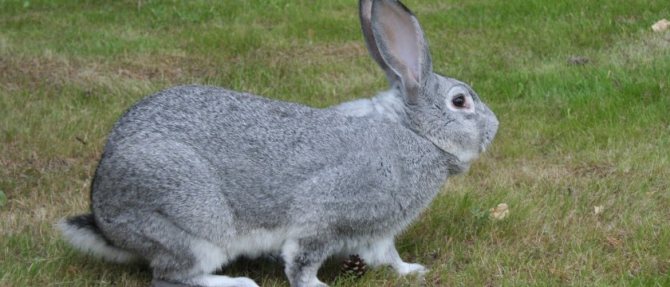

In addition to choosing the optimal feed, you should pay attention to the nutritional norms of rabbits in winter:
- In order for the digestion processes to proceed normally, and the animals do not suffer from hunger, food must be dispensed at the same time.
- Dry grass laid out in troughs for constant access must be fresh. In no case should it be allowed to start to rot or become moldy.
- The minimum frequency of feeding should be 2 times a day, although ideally, feed should be dispensed up to 6 times a day.
- The daily feed rate should be as follows: juicy 200 grams, rough or concentrates - 60 grams and about 150 grams of hay.
- If the animals are preparing for mating, you need to increase the amount of roughage and concentrated feed in the diet to 100 grams per day. The proportion of hay in the diet also increases (up to 200 grams per individual), while the amount of succulent feed remains the same.
- Females should receive 250 grams of succulent feed, 130 grams of roughage and concentrates and no more than 200 grams of hay per day.
- During lactation, the diet is based on succulent feed. Their amount should be up to 500 grams per day. In addition, about 250 grams of hay and 140-160 grams of rough and concentrated feed are given to one individual per day.
These norms are acceptable only for adults, and the diet of young animals up to three months of age should be the same as that of lactating females.
Hay is considered a favorite winter delicacy for rabbits, because in the cold season they do not have access to green fodder. Experienced livestock breeders try to prepare in advance a sufficient amount of dried grass so that there is enough of it for the animals for the entire wintering period. But no one is immune from a situation when winter is not over yet, and hay stocks are already running out. What to do in such a situation?
First assess the supply of dried grass, and if there are not enough, feed it primarily to pregnant and lactating females, and young animals. The rest of the individuals can be given branch feed or straw. In addition, for a short time, hay can be replaced with high-quality cereal straw. The only exceptions are individuals intended for mating. They should also provide at least a small amount of hay.
The issue of feeding rabbits in winter is discussed in more detail in the video.
When starting rabbits, it is important to know the list of products that will provide the animals with harmonious development, fast growth rates and healthy offspring.
Their appetite is insatiable. Healthy animals are ready to chew aromatic fresh food all day long. The problem of nutrition in the summer is not difficult to solve: on the lawn, the eared ears can nibble on the juicy green grass, and they will not give up vegetable tops.
In winter, as in summer, rabbits need good nutrition, including vitamins, fats, proteins, carbohydrates. The diet of animals should not only be varied, but also balanced.
Among the "winter" types of products are:
- hay, the amount of which in the daily rabbit menu reaches 60%;
- branches of juniper, aspen, spruce, other trees, with the exception of those in which hydrocyanic acid, which is poisonous for fluffies, is present: plum, peach, cherry, sweet cherry and others;
- cereals: wheat, corn, barley, millet;
- legumes: peas, lentils, beans;
- root vegetables: potatoes, carrots, cabbage, which can be grown with the expectation of feeding rabbits.
Animals and special mixtures that sell in pet stores are happy to eat. A salt stone purchased and placed in the cage will help meet their salt needs.
In winter, with an abundance of dry food, it is necessary to provide the animal with a sufficient amount of water. Rabbits with a strong instinct for cleanliness will not drink dirty water that has not changed for several days.
There should always be sufficient fresh water and the troughs should be cleaned of food debris daily. For eared people, you need to plan a balanced, varied menu for the day.
During the day, the animals come to the feeders many times. The structure of the digestive tract of rabbits requires a constant supply of new food, which moves the digested food through the intestines.
Animals should have fresh hay at all times, so that they can constantly chew something. Rabbits will never be seduced by stale and moldy hay.
The quality of hay directly depends on the conditions of harvesting and storage.Meadow grass should be mowed in early summer, in June, before flowering begins, preferably on sunny warm days.
Slightly dry grass is dried under awnings on flooring with holes that provide free air circulation in the grass.
Rabbits will eat this hay with pleasure. An adult rabbit consumes about 40 kilograms of hay per year. A rabbit up to 4 months of age needs up to 10 kilograms of hay.
During the summer, it is necessary to prepare aromatic herbs that improve the digestion of rabbits, have antibacterial and anti-inflammatory properties, protecting animals from diseases.
Tansy, nettle, yarrow, dill twigs, wormwood rabbits can be fed all year round.
In winter, animals will enjoy eating alfalfa, young oat stalks, red clover, and Sudanese grass. It is recommended to add herbs to dried hay heaps.
Rabbits eat vitamin brooms from nettle very well. The plant is harvested in June and dried in bunches. Then you can grind the nettle and add to the mash.
In winter, rabbits are sometimes given millet or oat straw as feed. Other types are best used for bedding. Breeders do not use straw from marsh grasses due to its low nutritional value.
Herbal flour
If the hay is dry and rough, you can make grass flour out of it. To do this, the grass laid in a bag made of natural fabric is evenly, without pressing tightly, distributed over its entire volume. It is best to remove large, tough stems immediately.
Sufficiently dried hay is easy to grind into crumbs right in the bag. If there is no hay prepared according to all the rules, the grass flour will be eaten by the rabbits with a bang.
Carrot
The eared ears are very fond of crunching carrots: it's not for nothing that these characters in fairy tales invariably chew it. Sweet carrots are the best for rabbits.
Considering the high content of nutrients and vitamins in it, the preference for animals becomes clear. The pussies will also like the "dish" made from chopped beets, cabbage and carrots mixed with crushed.
Proper nutrition for rabbits
You need to feed the rabbit systematically in winter. If you give food at different times, pets will not know exactly when to wait for food, and therefore will only do this.
Experts recommend feeding the pussies at least 2 times a day, because because of their daily employment, the owners often cannot feed the rabbits 5-6 times a day. Animals pay attention not only to food, but also to dampness and dirt. If sanitary standards are not followed, rabbits often get sick, and a weakened immune system leads to death. All this must be taken into account.
One type of feeding is legumes. It is not necessary to abuse this in any case. The transition from summer vegetables and fruits to winter heavy foods should be gradual. Animals must first get used to new types of food. It is impossible to start feeding hay abruptly from December 1, everything must be done gradually for healthy development. Since animals are whimsical, even hay needs to be given special attention. It should always be fresh, and this directly depends on how to store it. It is necessary to dry the grass so that the wind passes through the blades of grass. This hay will always stay fresh.
If the hay is dry, you can make flour from this material. To do this, it is necessary to evenly lay the grass in a bag and after the drying period, crush it into flour.
Carrots should be included in the winter feeding of rabbits. Pets prefer sweet varieties. You can mix carrots and cabbage or carrots and beets. As for the twigs, all this must be harvested from early summer. The feeding process does not take much time for the farmers, since the female spends about 5 minutes a day feeding the rabbits.
What else do you need to know?
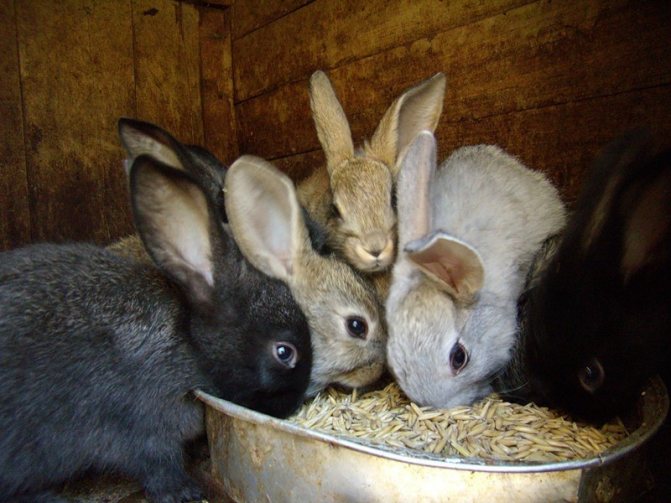

Experienced rabbit breeders warn: rabbits eat almost everything that they are given, but the structure of their digestive system requires special attention to these animals.
Here are some secrets to feeding rabbits in winter:
- To increase the digestibility of the grain, it is necessary to pre-soak it. The seeds will sprout in 2-3 days. During this time, they are of great benefit to rabbits, and they are much easier to chew.
- When harvesting branches, you should avoid buckthorn, elderberry, wild rosemary, bird cherry, apricot, with which animals can be poisoned.
- It is not recommended to give potato and tomato tops to the eared ones. Potato tops are especially dangerous during the flowering period.
Norms and regime
Pets eat quite often during the day. To prevent food spoilage, you cannot leave it for a long time in the feeders. It is better to put hay, which the eared ones can chew on.
For home feeding, you should not replace hay with straw, since the amount of useful trace elements and vitamins in them is different. Hay is much more useful for rabbits. At night, rabbits eat their waste, because their digestive system is designed in such a way that the rectum is able to remove useful elements from the body from the same hay. When the animals eat it again, the assimilation process is facilitated. Also, rabbits are able to eat homemade food: porridge or soups. At the same time, food should not be greasy for them.
Eating rabbits outside in winter should be more high in calories. Also, in winter, under home feeding conditions, individuals are given food about 2-5 times a day, since they eat little. To keep the food from freezing, they give a new one.
At home, feeding rabbits should be done as often as required. During molting, pregnancy and just winter maintenance, individuals are given vitamin and mineral supplements.
Useful Tips
When purchasing a hectic rabbit farm, one must assume that the most important thing for them is a sufficient amount of tasty, fresh and varied food. Grass harvesting is an important part of feeding rabbits during the winter. Indeed, in addition to the content of vitamins, herbs have anti-inflammatory and antibacterial effects. It is recommended that there be enough wormwood, yarrow, dill. Grass is also added to dry meadow harvests. If there is no hay, they are combined with compound feeds as a tasty addition. This allows the eared ears to endure the winter period and give healthy offspring even at this time.
Rabbits are omnivorous and have a calm disposition. But their digestive system functions in such a way that an unhealthy diet can lead to serious illness.
Diet during the mating period
This period in rabbits is one of the most important in life, so in winter conditions it is worth paying attention to their diet, which should contain fiber, essential vitamins, proteins and minerals. All this is found in foods such as barley, vegetables, fruits, flour. The proportions are as follows: for 100 g of rabbit food, 30 g of cake / bran, 15 g of protein and 4 g of mineral supplements are needed. If you overfeed them with any of the foods, they are unlikely to please healthy offspring.
A month before mating, you can give 90 g of feed, no more. During the mating period itself, you need to pay attention to the so-called juicy feed. These include carrots, beets, cabbage, and onions. It is necessary to take into account one more feature of rabbits during this period: the time of their feeding. Since the females are ready to mate, this process takes about 4 hours in the morning. Food should not be given at this time.
The approximate diet of males: flour - 15 g; hay - 150 g; juicy feed - 200 g; feed - 50 g. Females: flour - 8 g; hay - 200 g; juicy feed - 225 g; feed - up to 60 g. The amount of food is also calculated by the weight and dimensions of the animal. Do not feed all individuals equally.Such nutrition allows animals to remain active and energetic in the cold season, as well as to safely complete the mating process, which is important for the future healthy generation.
How to raise a litter?
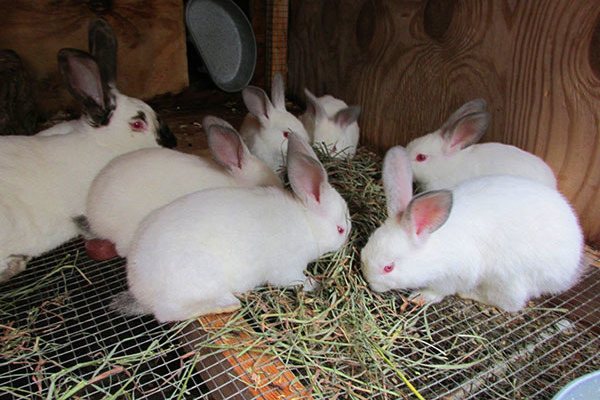

Newborn rabbits have very delicate stomachs that are completely unprepared to digest rough, regular food. Sometimes the rabbit does not have enough milk to feed the offspring. For this reason, it is quite acceptable to feed the rabbits in winter with cow's milk, kefir or whey.
You can add feed to the diet so that they gain weight, but juicy foods are recommended to be given no earlier than 3 months. The dairy menu begins to be cut by a quarter when the rabbits are 1 month old. Babies start to cut their teeth. During this period, you can already begin to feed them with bran and very small portions of hay. Rabbits should always have fresh water for drinking. You always have to watch them, because if they do not drink themselves, they have to drink from a pipette or syringe.
How to feed a rabbit at home
In most cases, rabbits are bred at home in order to get healthy dietary meat and warm fur. The quality of meat products and fur is highly dependent on proper nutrition. Before you start breeding rabbits, you need to carefully study the features of feeding animals, what rabbits like, than feeding rabbits for quick weight gain, learn in detail about food habits at different times of the year. Rabbits should grow up healthy, without digestive upset.
What temperature can rabbits withstand?
Rabbits have long been cultivated in the household due to not too troublesome care and the opportunity to get fur and tasty meat. Those who wish to breed them should understand that the dwelling for these animals will need to be equipped for both the warm and cold seasons. In order to grow healthy individuals, it is important to establish a diet, provide the right amount of water, and also ensure the optimal temperature range.
You can keep rabbits in a private house in an aviary, in the country - in cages. Animals can live there both in summer and winter, the main thing is to give them everything they need in a specific period. The most important thing is to keep them outdoors in winter, as there is always a risk of hypothermia and illness of pets.
To prevent this from happening, it is important to know exactly at what temperature the rabbits will feel normal and which will become dangerous for them.
In winter, fluffy animals will feel normal until frost at -12 degrees, without receiving negative consequences. A short-term decrease in the thermometer to -17 degrees will also be normal for the animals, although not for a long time. If the rabbit is completely healthy, then it can withstand severe frosts down to -30, but for a very short amount of time.
Staying in the cold is beneficial for pets, as it allows them to harden the body and get less sick.
Breeding and keeping rabbits in winter is not much more difficult and costly than in the warm season, because there is no need to arrange a special room in which the animals will be warm, you just need to insulate their cages. A significant advantage of winter care for animals is that the risk of ammonia fumes poisoning is minimized, which means that the livestock is born healthy, without the premature death of a certain percentage of the total mass.
Winter feeding rabbits
So what to feed the rabbits in the winter at home? Feeding rabbits in winter should be no less nutritious and balanced than in summer. In winter, the rabbits' main food is missing - fresh grass. Therefore, it is imperative to make preparations for the winter in the summer. The types of winter food for rabbits are as follows:
- The main component in the diet of rabbits is hay (legumes, dry clover);
- Juniper, pine, spruce twigs;
- Root vegetables - carrots, potatoes, cabbage;
- Cereals - corn, barley, wheat;
- Legumes - beans, peas, lentils;
In the absence of hay for the ration of rabbits, special ready-made mixtures can be purchased at pet stores.
Besides hay, animals are also very fond of leaves from trees. Fluffy wards will not refuse from the bark of trees, except for tanning breeds.
It is unacceptable to feed rabbits with branches of cherries, peaches, plums or cherries due to the presence of hydrocyanic acid in these trees, which is very poisonous for rabbits
A salt stone can be placed in the cage to meet the salt requirements of the animals.
It is very important to clean the feeders every day and provide the rabbits with clean, warm water. Rabbits have a very developed instinct for cleanliness, they will not drink polluted water.
The diet of rabbits should be varied. It is important to understand and learn how to properly feed rabbits at home.
How to water the eared ears?
Greenhouses, greenhouses, the street - it doesn't matter where the animals live. All of them, without exception, just need to drink water from a drinking bowl for rabbits for normal life. Access to fresh water should be around the clock. Exclusively dry rations are unacceptable for them, since it will provoke metabolic disorders and the rapid death of the animal. Each cage must have its own drinking bowls for rabbits.
Drinking bowls for rabbits are a necessary attribute of animal care. It has been proven that a lack of water leads to the fact that the eared ears begin to drink their urine. This process will adversely affect the growth and development of young animals. Therefore, the correct drinker is just as important as the correct feeding.
How to water rabbits in winter? Liquid freezes very quickly in frosty weather, so it is better to pour warm water into the drinking bowls for rabbits. You need to replenish water supplies twice a day. Many people practice a special technique. Watering rabbits in winter is often replaced with snow. But they do this only when this is the only way to quench their thirst. Snow, which is filled with drinkers for rabbits, must be absolutely clean.
Feeding rules
It's important to love animals and understand what to feed your rabbits to gain weight.
The better to feed the rabbits. Key recommendations in animal nutrition are as follows:
- Receiving a portion of food at the same time;
- Availability of fresh food in the feeders;
- The number of feedings should not be less than two - in the morning and in the evening, when the rabbits have a particularly strong appetite;
- The optimal number of feedings is five to six times, but it is difficult to comply with;
Animal cages should be perfectly clean, there should be no high humidity, no drafts, but well ventilated.
The transition from the summer diet to the winter diet should not be carried out abruptly. Portions of green grass do not drop sharply, every day, replacing them with hay and other components of the winter diet.
Rabbits have this feature of the digestive tractthat food should flow in without interruption and push the digested food through the intestinal tract. But at the same time, the food should always remain fresh and not sour. For this, it is advisable to place fresh hay in the cages. Sometimes, in the absence of hay, breeders use straw, but it has fewer nutrients, so it is recommended to use straw as bedding.
Often in winter, rabbits consume their droppings at night. The reason for this is that when dry food is split, nutrients are released that do not have time to enter the body due to the fact that the muscular system of the rectum quickly throws them out. Therefore, when recycled, all useful substances are already assimilated.
If you follow all the basic points of feeding correctly, then in winter the rabbits will gain weight and reproduce well.
Feeding rabbits for weight gain
Vegetable and forage impurities are introduced into the food of rabbits from 2-3 months.The composition of feed at each age stage is different.
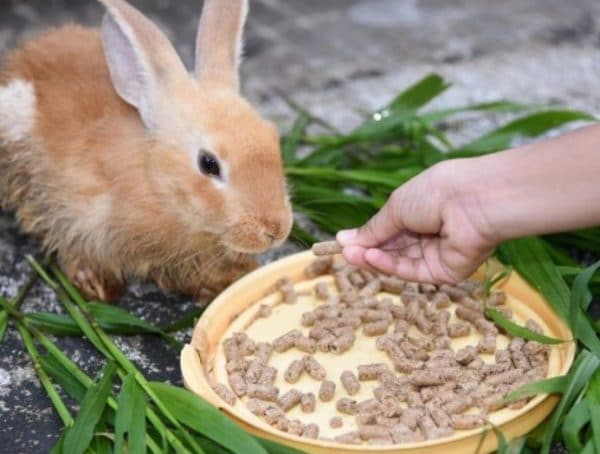

Without special fattening, the farm will not only be left without profit, but will not even recoup the costs of keeping the eared
The process of feeding rabbits involves three stages:
- preliminary (selection of a suitable diet);
- main (weight gain of pets);
- final (correction of weight and body fat).
The first period is characterized by increased feeding of young animals.
In summer and winter, it is based on combined mixtures:
- wheat;
- legumes;
- oats;
- corn.
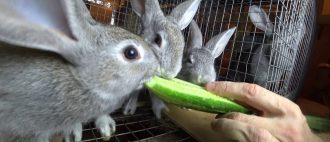

Be sure to read:
Is it possible to feed rabbits with zucchini, cucumbers, apples and pumpkin, in what form, at what age
The preparation stage is 5 days.
The main stage is aimed at the formation of the fat layer.
Animal nutrition includes products with fat content:
- Boiled potatoes);
- flax seeds;
- cake.
Porridge with milk is added to the daily diet of rabbits. The feeding period lasts 7-10 days.
The final stage involves maintaining the animals' appetite.
Hay and grass are excluded during the last days of feeding.
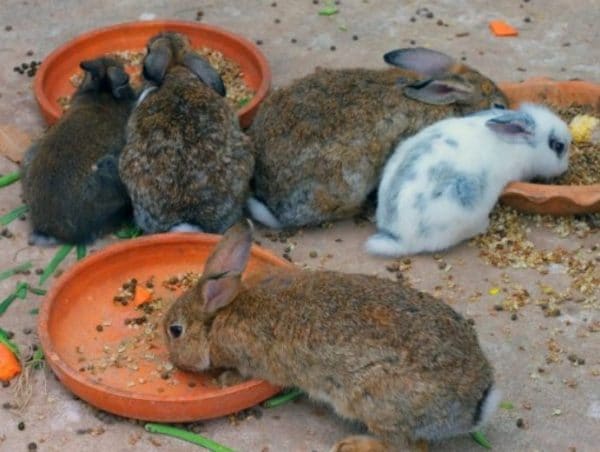

Be sure to give your eared enough clean water. In frosts, it is preferable to pour warm water into the drinkers
The use of exclusively compound feed is typical for industrial fur farms. For a mature individual, consumption per day is 100-110 g of compound feed, in which 55% is cereals, corn, oats, 45% is cake and bran.
The nutrition of rabbits becomes complete due to the inclusion in the daily diet, in addition to compound feed, auxiliary feeds, which are subdivided by type:
- green - a combined group of fresh plants (grass, tree leaves);
- juicy - represented by fruits and vegetables;
- rough - hay.
With mixed feeding, the dosage of compound feed per day is half as much (40-50 g), with the exception of:
- female dolls, who are supposed to be 90 g - in summer, 100 g - in winter;
- lactating rabbits - 130 g in summer, 150 g - in winter.
Table 1. Annual feed requirement for combined feeding
| Species of an individual | Stern | Quantity (kg) |
| Lactating female (24 bunnies) | Compound feed | 342 |
| Hay | 109 | |
| Silage, root crops | 90 | |
| Fresh grass | 420 |
The dimensions of the feeding cages are due to:
- the number of young animals;
- the number of mature rodents;
- place of keeping animals.
General principles of organizing the dwelling of animals:
- Thoughtful location of the territory for maintenance (no drafts and strong winds).
- The choice of wood as a material for the frame and supports, for walls - plywood or mesh.
- Keeping males separate from pregnant rabbits and their joint offspring.
- Typical parameters of the cage for an adult are 1500x700x700 mm.
Table 2. Minimum sizes for keeping pets
| Classification | Norm area 1 head (sq. M) | Length (cm) | Width (cm) |
| For the main herd (two-section) | 1st section - 0.5-0.62nd section (nest compartment) - 0.18 | 60-7050 | 9036 |
| For females (for 4 individuals) | 0,15 | 90 | 672 |
| For males (for one) | 0,605 | 90 | 672 |
| For young animals | 0,13-0,16 | 29-36 | 45 |
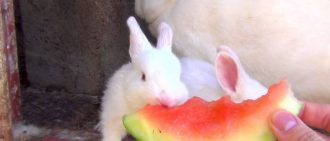

Be sure to read:
Is it possible to feed rabbits with watermelon peels, especially decorative ones, do they eat peels at all?
During the okrol period, the cubs are kept together with the rabbit until they get stronger. For the convenience of cleaning, the feeding boxes are made retractable or suspended.
Finished cells are placed at a distance of 20-50 cm from the floor. This will protect young rabbits from rodents.
Rules for the preparation of winter food for rabbits
Hay should only be of the highest quality, in no case have mold.
For hay to be of good quality, it must be properly harvested and stored. Grass in meadows begins to be mowed at the beginning of summer, before flowering on sunny days. It is then dried on perforated flooring. If the hay has not been preserved well, then it can be processed into grass flour. For this procedure, the hay is placed in a bag, after removing large stems, dried, and then chopped.
Since rabbits are very fond of sweet carrots, beets, cauliflower or Brussels sprouts (if given white cabbage, flatulence can develop), they can be chopped and mixed with hay flour.
Nettle shoots, which are harvested in early summer, are useful harvesting for animals.
We must not forget about harvesting twigs and tree bark since the summer. With them, fluffy pets in the diet receive various trace elements, and also use them for turning teeth.
Features of feeding in winter during the mating season
During this period, it is necessary to especially monitor the nutrition of the rabbits. Food should have protein components, animal and vegetable origin, such as corn, barley, as well as a lot of vitamins contained in vegetables, fruits, fiber, and one should not forget about minerals. It is quite possible to implement a balanced diet at home, but it is important to observe proportions, not to abuse carbohydrate foods.
To males it is not advisable to be overweightbut severely emaciated rabbits can also have breeding problems. During the mating period, it is necessary for the rabbits to give more carrots, beets, cauliflower, dry herbs. It is better to reduce cereals and compound feed during this period to prevent obesity.
The approximate composition of the diet of males during the mating period is as follows:
- Meat and bone meal - fifteen grams
- Hay - about 150 grams
- Juicy feed - two hundred grams
- Concentrated feed - 50 grams
For rabbits, hay and succulent feed are given at 200 and 225 grams, respectively, meat and bone meal - about 8 grams, concentrated feed - 60 grams.
The correct menu during the mating period will allow you to successfully complete this important process.

